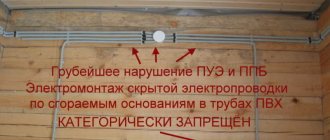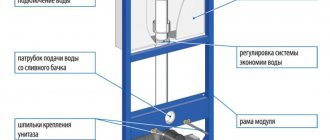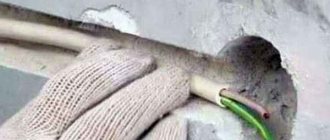Safety precautions. Basic rules for handling electricity
- When working with electrical appliances, always remove the plug from the socket.
- When installing electrical equipment, you should turn off the fuse in the electrical circuit you are working on.
- Hang a warning sign on the fuse box to prevent the fuse from being accidentally turned on while you are working.
- Before starting work, check using appropriate measuring instruments that there is indeed no voltage in the network.
- Only a professional electrician can carry out all work on fuses, switchgear, meter, grounding and input voltage. 6. Never attempt to repair damaged cables, plugs or couplings - they must simply be replaced.
In order not to create dangerous situations both for yourself and for others, you must strictly follow the following basic rules during work on installing electrical equipment, as well as during repairs of electrical appliances: never try to repair fuses yourself, in this case the electrical wiring or electrical appliances may experience severe damage. load or fail, and there is also a risk of fire. Please note that only an electrician can replace the fuse with a more powerful one or install a new circuit breaker.
How is outdoor electrical equipment installed?
When it comes to substations, many factors are taken into account when forming them. Of course, you need to have an idea of what voltage will be supplied to such a device and what current characteristics should be obtained as a result. However, you should also know what the power of the object or group of objects that will be connected to such a substation will be. Currently, there are two approaches to creating equipment for trunk lines. The first involves the creation of substations according to an individual project, which requires a long time and high costs. Therefore, in practice, the installation of complete substations assembled at the factory is much more often used. An example of such a device is shown in the following photo.
Next, you need to decide whether the cable will be laid along an overpass, underground or on supports. Also, during installation you will have to comply with a number of requirements. In particular, the substation should always be located on a level surface. Metal channels used as a base must deviate from the required level by no more than 1 mm/meter, or 5 millimeters along the entire length of the device. If it is necessary to obtain a very powerful device, complete substations can be connected to each other by special buses, which makes it possible to obtain a single circuit.
Why should only a specialist install electrical equipment?
Any equipment for electrical networks, regardless of its purpose, has a rather complex structure. Therefore, its connection can only be carried out by a person who has an understanding of the basic principles of electrical engineering, as well as the structure of the specific electrical network with which the work will be carried out.
In addition, if we are talking about transformer and distribution substations, most likely, you will have to work with increased voltage, capable of reaching 6-35 kV. Such electric current can cause significant damage to human health, including irreparable damage. Therefore, any repair and installation work related to high-power electrical equipment must be carried out by a qualified specialist wearing protective equipment.
Below you can use the online calculator to calculate the cost of electrical installation work.
Installation nuances
Electrical installation work begins with planning. The main task is to find a rational installation option. The complex amount of work begins with drawing up a network schedule. It indicates the list of work that needs to be performed, the sequence and duration of completion, and their relationship. After approval of the network schedule, electrical equipment installers begin work.
In the case of carrying out work on the power supply of an apartment, private house, office or other objects, first of all the circuit diagram is studied. Next, all the necessary system components are purchased and delivered to the work site, the technology for installing electrical equipment, the necessary tools and control devices are selected.
In an apartment or private house, household equipment is connected taking into account its energy consumption. In addition, you must adhere to these basic rules:
- wires are laid only horizontally and vertically;
- electricity meters, switches, sockets, distribution boxes and equipment must be installed so that they are easy to maintain;
- the number of sockets must be at least 1 for every 6 m2 of room, in the kitchen - at least 3, regardless of its area;
- connections and branches of wires must be mounted in junction and branch boxes;
- A separate line is installed to power powerful electrical equipment.
Electric motor installation technology
Electrical equipment repair
The engine can be delivered to the installation site directly from the manufacturer, from the warehouse and after repair work. It can be installed on a steel or cast iron plate, a welded metal frame, a special slide or bracket. All these elements must be aligned along the axes of the engine installation in a horizontal plane and secured with foundation bolts. Holes for them are usually made during construction work, if this is provided for in the working design. In this case, plugs made of wood are left in the required places in advance.
If this is not provided for by the project, then markings are first carried out according to the installation and installation dimensions, which are specified in the manufacturer’s instructions. Then holes of the required diameter are punched using pneumatic or electric hammers. It is also necessary to measure the height to the axis of the engine shaft in order to determine the thickness of the lining installed under the paws. It should not exceed 5 mm. This is the only way to ensure correct alignment of the electric motor. The reliability of the product depends on this indicator. Currently, shaft alignment is performed using laser systems, which allows alignment with a high degree of accuracy, which will affect the service life.
If engines have a V-belt or belt drive, a necessary condition for their proper operation is compliance with two factors - parallelism of the shafts and coincidence of the center lines of the pulleys. Only under such conditions will the belt not slip off. Here you need to use a straight edge to check the distance between the centers of the shafts and the width of the pulleys. The ruler should touch two pulleys at 4 points. But such an alignment can be performed when the distance between the axes of the shafts does not exceed 1.5 m. If this size is exceeded, this will require a steel string and brackets, which are temporarily installed on the pulleys. Alignment can be carried out using a thin cord. It is stretched between the pulleys.
With different widths of pulleys, the condition of the same distance from the center lines of the pulleys to the alignment ruler, string or lace must be observed.
After alignment, the electric motor is securely and firmly fixed to the base with bolts. Then the reconciliation is checked again - it should not be violated.
Engines weighing up to 50 kg are installed manually, above this figure - using lifting mechanisms.
Before installing the electric motor, it is necessary to measure the insulation resistance. For direct current products, such a measurement is performed between the armature and field coils, and also checks the insulation resistance of brushes, field coils and armature in relation to the housing.
For an electric motor with a squirrel-cage rotor, the insulation resistance is measured from the stator windings to the housing and in relation to each other and to the housing. But this depends on the number of windings removed. If there are 3 of them, then they are measured only in relation to the housing, if there are 6, then the measurement of the stator windings is added.
For products with a wound rotor, 2 more types of insulation resistance are measured:
- between stator and rotor;
- brushes in relation to the body.
If the measurement results comply with the standards, the electric motors are switched on. If there are deviations, the winding insulation must be dried.
After installing the electric motor, it is put into operation. According to existing regulations, products are checked for running-in - powerful after 72 hours. after start-up, the rest after 24 ÷ 48 hours. To do this, technical diagnostics of vibration and temperature parameters are performed using appropriate devices (vibration analyzer, thermal imager). In addition, the parameters of lubricants and oils are monitored using a special mini laboratory.
Fuses in the electrical circuit
If you decide to install electrical equipment yourself, you should have basic information about fuses. Fuses are the most important protective element in home electrical equipment, as they cut off the electrical current in the event of a short circuit or overload in the network. There are different types of fuses.
- Fuses must be replaced after each blowout.
- Automatic thread fuses open when there is a short circuit or as a result of an overload in the network, after which they can be turned on again by pressing the black button located in the center of the fuse.
- Today, households mainly use circuit breakers. When there is a short circuit or overload in the network, they open the switch, as a result of which the current supply is interrupted. To turn it on, you just need to switch the switch.
Correct location and placement of electrical equipment; plan of the electrical equipment of the room
For the location of electrical wiring and installation of electrical appliances in the room, there are zones that are recommended to be observed. All electrical wires should be laid only vertically or horizontally, but not diagonally.
- In residential premises, the distance between horizontal wiring and the ceiling or floor should be 30 cm; for vertical wiring it is 15 cm to the corner of the room, door frame and window corners. It is advisable to place switches at a height of 105 cm, and sockets - 30 cm from the floor.
- In the kitchen and work areas, the distances are the same, with the exception of switches and sockets, which are located at a height of 115 cm from the floor. Sockets for hard connections, such as for kitchen stoves, are located at a height of 30 cm.
Advantages and disadvantages of installation services
Electrical installation in a private house, ordered from a specialized company, provides the following advantages:
- drawing up a contract for work;
- providing a guarantee for work, equipment and materials;
- high-quality execution of tasks of any complexity;
- competent execution of working documentation;
- installation of an electrical network in accordance with the requirements of SNiP and RosTechnadzor;
- operational safety and reliability of the electrical network.
The only disadvantage can be considered the cost of electrical installation work by specialists, but do not forget that the safety of life in a country house depends on the quality of installation.
Stages of installation of electrical equipment
Installation of electrical equipment at an enterprise or other facility includes:
- Preparatory stage - preparation of wiring units and lighting lines, preparation of routes for laying wires and grounding elements, installation of embedded parts for further fastening of equipment. These works are carried out simultaneously with construction and finishing activities.
- Laying cables and wiring along prepared routes, with serial connection. In industrial premises, this work is carried out in parallel with the installation of electrical equipment.
- Carrying out electrical measurements and insulation resistance measurements. Preparation of a technical report.
- Performing commissioning work:
- study of design and technical documentation;
- checking the readiness of electrical equipment for commissioning;
- searching for faults that occurred during installation;
- startup of electrical installation;
- adjustment of electrical equipment;
- preparation of the Equipment Acceptance Certificate and technical report.
When carrying out installation work, it is important to comply with all the requirements of current regulatory documents (PUE, SNIP, PTE, TNP, PTB). It is also necessary to strictly follow the decisions and parameters specified in the project and technical documentation, and strictly adhere to the installation requirements set out in the instructions for the equipment.
Installation of power electrical equipment
Features of installing light sources
Power electrical equipment is low- and high-voltage devices, lines and auxiliary products intended for production, transformation, transmission,
distribution and conversion of electrical energy into the required type of energy. According to their intended purpose, power plants can be domestic or industrial. They are also characterized by voltage - up to 1000 V and higher. They can be stationary or mobile. By design, they can be complete or individual. According to location - free-standing and built-in.
All of them pose a danger to humans if handled improperly. Their installation must take into account special requirements. They can be installed on existing facilities, newly built ones, or under renovation. Installation of power electrical equipment should only be carried out by electricians who specialize in a particular type of installation. The list of works they carry out is quite extensive:
- installation of power lines;
- installation of internal power supply systems;
- installation of floor and individual switchboards, input distribution devices, distribution points;
- installation of electric lighting products and equipment indoors and outdoors;
- installation of transformer substations;
- installation of backup power supplies;
- connecting various equipment to electrical networks of energy transmission companies.
Installation of industrial electrical equipment
Installation of industrial electrical equipment is a responsible and labor-intensive process that requires a professional approach at all stages. Violations during transportation and unloading of equipment, as well as errors in design and installation, negatively affect the operation of electrical installations and can ultimately lead to an accident. To prevent such consequences, the installation of electrical equipment must be entrusted to competent specialists who guarantee high-quality performance of work of any complexity.
Our company installs electrical equipment in facilities for various purposes - from residential and administrative buildings to shopping, entertainment and office centers, warehouses and industrial enterprises. We fulfill our obligations professionally, on time and in full accordance with the concluded contract.
Projects are compiled in accordance with customer requirements, operating standards and safety regulations. All work is carried out by experienced electricians with the necessary approvals, using certified components and installation devices from leading manufacturers.
Electrical equipment repair
Repair of electrical equipment is carried out during its operation in the event of emergency situations or failure of individual elements. The working life of most electrical installations is more than 20 years, which ensures the possibility of its operation throughout this entire period. But, in some cases, electrical equipment may fail when:
- violation of operating rules;
- non-compliance with operating conditions;
- increased load on working parts;
- improper operation of the protection and automation system.
Timely and high-quality repairs help restore the working life of electrical equipment and take measures to reduce the likelihood of emergency failure of electrical equipment.
Specialists perform professional installation, testing, adjustment and repair of electrical equipment. Compliance with all recommendations of the manufacturer and other requirements of regulatory documents ensures impeccable quality of work and compliance with all agreed deadlines.











